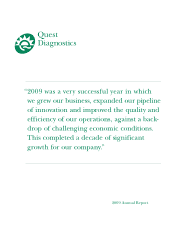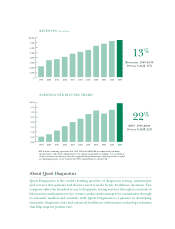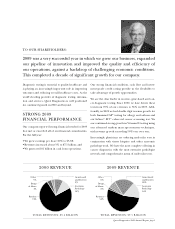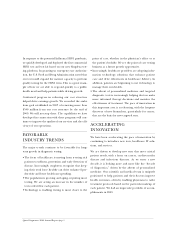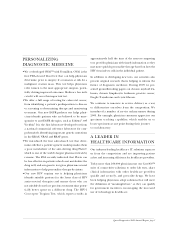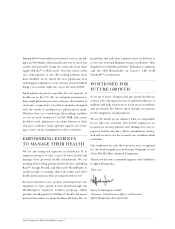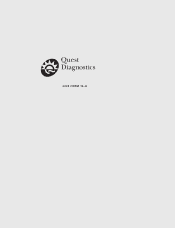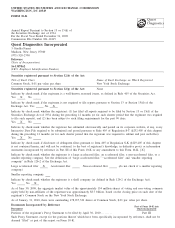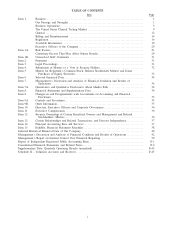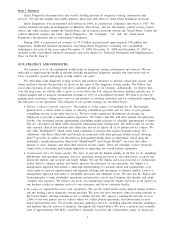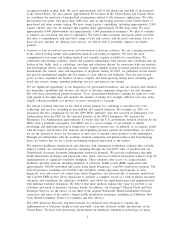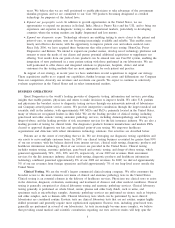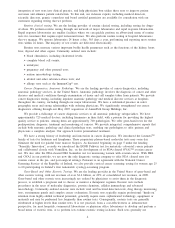Quest Diagnostics 2009 Annual Report Download - page 5
Download and view the complete annual report
Please find page 5 of the 2009 Quest Diagnostics annual report below. You can navigate through the pages in the report by either clicking on the pages listed below, or by using the keyword search tool below to find specific information within the annual report.
PERSONALIZING
DIAGNOSTIC MEDICINE
• We co-developed OVA1™ with Vermillion. OVA1 is the
first FDA-cleared blood test that can help physicians
determine, prior to surgery, if a woman is at risk for a
malignant ovarian mass. This test helps physicians
refer women to the most appropriate surgeon, poten-
tially driving improved outcomes. Medicare has indi-
cated it will cover this important test.
• We offer a full range of testing for colorectal cancer,
from identifying a patient’s predisposition to disease
to screening to determining therapy and monitoring
treatment. Our new EGFR pathway test helps physi-
cians identify patients who are believed to be unre-
sponsive to anti-EGFR therapies, such as Erbitux® and
Vectibix.
® It is the first laboratory-developed test from
a national commercial reference laboratory for com-
prehensively identifying important genetic mutations
in the KRAS, NRAS and BRAF genes.
• We introduced the first saliva-based test that deter-
mines whether a patient’s genetic makeup makes them
a poor metabolizer of the anti-clotting drug Plavix®
,
which is one of the world’s largest pharmaceuticals by
revenue. The FDA recently indicated that Plavix can
be less effective in patients who do not metabolize the
drug well, and our genetic test gives physicians crucial
information to help personalize therapy decisions.
• Our new HIV tropism test is helping physicians
identify suitable patients for the latest class of HIV
antiretroviral therapies and ensure those who are
not suitable do not lose precious treatment time poten-
tially better spent on a different drug. The HIV-1
Coreceptor Tropism Test, which reports results in
approximately half the time of the nearest competing
test, provides physicians with timely information so they
may more quickly personalize therapy based on how the
HIV virus infects cells in the individual patient.
In addition to developing new tests, our scientists also
present original research that is helping to inform the
future of diagnostic medicine. During 2009 we pre-
sented groundbreaking papers on chronic myeloid leu-
kemia, chronic lymphocytic leukemia, prostate cancer,
Fragile X syndrome and cystic fibrosis.
We continue to innovate in service delivery as a way
to differentiate ourselves from the competition. We
introduced a number of service enhancements during
2009. For example, physician customers appreciate our
specimen tracking capability, which enables us to
locate specimens at any point during their journey
to our laboratory.
A LEADER IN
HEALTHCARE INFORMATION
Our industry-leading healthcare IT solutions separate
us from the competition and are improving patient
safety and increasing efficiency for healthcare providers.
Today more than 160,000 physicians use our Care360™
suite of connectivity solutions to order lab tests, share
clinical information with other healthcare providers
quickly and securely, and prescribe drugs. We have
been helping physicians adopt solutions that will meet
the definition of “meaningful use,” so they can qualify
for government incentives encouraging the increased
use of technology in healthcare.
Quest Diagnostics 2009 Annual Report page 3

